When it comes to managing large data sets, the traditional in-house IT infrastructure is no longer sufficient. Companies are now turning to cloud services, such as Amazon Web Services (AWS) and Microsoft Azure, in order to take advantage of the scalability, flexibility, and cost savings they offer. In this article, we look at 7 reasons why cloud services are becoming increasingly popular for big data and analytics projects.

1. Improved Cost Efficiency:
Cloud computing solutions allow companies to pay only for actual usage, rather than making upfront investments for hardware and software that might become obsolete over time. This offers an improved cost efficiency when compared to building in-house data centers.
2. Increased Scalability:
With cloud solutions you can quickly increase or decrease the number of resources available as needed by adding more computing power from a third party provider rather than having to manage an increasing number of physical servers on premise. As your needs change, so does the capacity of resources available for your project.
3. Enhanced Security:
Cloud vendors use sophisticated technologies that provide enhanced levels of security for data stored on their platforms – ensuring sensitive information remains private and secure at all times. Furthermore cloud providers will typically offer additional products such as DDos protection which can act proactively against cyber threats before they become a problem.
4. Reduced Maintenance Costs:
With cloud solutions there’s no need to purchase additional hardware or software – resulting in simplified maintenance costs thanks to its “pay as you go” model – allowing businesses to save money since there is no need to maintain the underlying infrastructure . On top of that many providers include maintenance packages options included within their plans which may further reduce costs associated with regular updates or troubleshooting projects related to performance or scalability issues.
5. Better Data Accessibility:
The robust nature of most cloud service providers ensure fast access across multiple geographical regions around the globe – making it easier and faster for organizations needing access large datasets stored off site or shared across multiple locations. Additionally while most systems allow both local access over LANs and remote access via secure SSL web connections some cloud hosting providers also come with mobile utility apps making even easier access hard-to-reach datasets while employees are out on business trips or attending conferences; making sure users can work with data even if they’re offsite without any disruption due their device not being physically connected with the corporate network via secure virtual networks (VPN).
6 High Availability Rates:
Most professional Cloud storage companies boast impressive uptime ratings ranging between 99%-100% guaranteeing availability rates significantly higher than those offered by home user ISPs internet plans; making sure data is always available when needed regardless internal technical problems like power failures or appliance breakage on premises thus reducing potential losses linked technological blackouts related with partially owned IT infrastructures where maintenance becomes exclusively within owner’s responsibility if something goes wrong .
7 Advanced Business Insights Enabled By Big Data Analytics:
Leveraging raw information gathered from customers’ behaviors lets organizations go beyond extractive reporting into predictive analytics providing better visibility into business performance using insights obtained by Dashboards created by processing vast amounts of multi-source structured / unstructured information gathered over long periods then interpreted based on historical patterns & trends enabling executives make more informed decisions& faster processes improving usability performance & customer experience outcome eventually leading improved overall ROI ratio metrics in operational activities across different verticals.
For More Articles, visit DataFifty.
